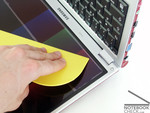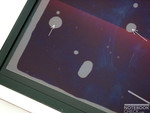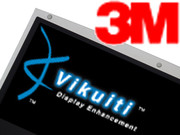Review Vikuiti ARMR200 Anti-Reflexion-Coating
At present much is discussed about display foils and coatings - no miracle, the majority of the notebooks at the market is equipped with a reflecting display. The Vikuiti display protective plastic foil ARMR200 promises to help the stressed eyes...
The Product
Beside the ARMR200 display protective foil we have already tested the Vikuiti [ weikjuidi ] viewing guard filter.
Both products originate from the renowned house 3M, which is responsible for a lot of innovative sticking products. Probably the most well-known of them are the small yellow papers, which can be glued almost everywhere.
First the idea to stick a foil at my loved display was horrifying for me - bubbles, sticking remainders, despaired scratching because the foil does not sit correctly - and that all with an expensive TFT panel?!?
Nevertheless I select a suitable test sample. I chose the Samsung Q30 for ridiculous 2,649. - Euro.
The Coating of the Foil
In the inconspicuous package beside a bundle of foils and a putty, between carton is a manual in four languages.
- Step1 - Cleaning the Display
In order to prevent, that dust particle or finger marks and other ugly traces surface are included under the foil at the display, first it must be cleaned extensively. Thereby above all helpful is an antistatic cleaning detergent, since otherwise within seconds the surface is covered again with dust particles after wiping off.
If you are content with the result, you should proceed briskly with the next point.
- Step2 – Removing the Protection Foil
The side of the display filter, which is provided with a special adhesive, is covered with a protective foil. Now this has to be removed. Well visibly marked with a handy white strip, the foil is taken off and the filter is ready for the display. Particularly in this phase it is necessary to avoid carefully impurities like dust particles and finger marks. Carrying gloves as recommended in the manual can be quite helpful thereby.
- Step3 – Application of the Foil
After a further check of the cleanliness of the display the foil is set at a display edge and applied on the display by means of the provided putty. Here the proceeding from below upwards over the transverse side of the display is recommended, since otherwise problems with the accuracy of fitting may occur. If you should have worked somewhat carelessly, this will be punished directly by ugly blisters in the foil. In this case simply raise the foil somewhat, remove the dust particles and coat the foil smooth.
During the test 2 foils were necessary until an acceptable result was possible, because again and again dirt particles (see picture) or a not absolutely right-angled fitting lead to a failure. The foils can be taken off and fit again without, but the danger of contamination increases with each attempt more and more. Blisters should not be pressed out by force, this could damage the foil or the display. It is better to raise the foil slightly again and carefully delete the blisters.
Note: 3M tells, that the foil can be washed off with clear water simply in the case of a contamination of the sticking side. Afterwards let it dry and try again.
In the case of a not properly matching foil this can be shape-cut to the wished form, but the sucking effect of the adhesive is lost at the cut borders. This can be recognized in some images. However at the original edges the foil sticks fullly. That is the reason why 3M cuts the foils for each model exactly in order to avoid unprofessional tinkering.
The Result
The Foil sticks and fits, blisters are deleted and finger marks are removed from the display. In the switched off condition of the display the functioning of the foil can be observed well.
Arising reflections are almost completely removed, and avoided by a gentle veil on the display. How will the foil work during the operation of the display?
According to experience switching on the display with maximum brightness decreases the arising of reflections, at least with normal environment lighting conditions in closed rooms.
This also can be observed with our test sample the Samsung Q30. Arising reflections are strongly weakened and are hardly any more disturbing.
Image Representation
Naturally the question remains with a filter, whether the quality and the remainder brightness are sufficient. Around this to examine we led ours admit proven brightness measurement through. Therefore we realized our known brightness measurement.
| 141.1 cd/m² | 191.7 cd/m² | 133.5 cd/m² |
| 160.1 cd/m² | 173.1 cd/m² | 146.3 cd/m² |
| 151.2 cd/m² | 158.4 cd/m² | 143.6 cd/m² |
| 139.4 cd/m² | 179.4 cd/m² | 132.4 cd/m² |
| 146.0 cd/m² | 169.2 cd/m² | 143.4 cd/m² |
| 151.1 cd/m² | 151.2 cd/m² | 135.5 cd/m² |
Which was to be observed subjectively was confirmed by the measurement: The applied filter affects the brightness of the display only minimal, also the color representation is not impaired. On average a reduction of the brightness could be measured around approximately 6.8 cd/m². This corresponds in about 3.6% of the maximally measured value.
In the color diagram a slight decrease of all colour curves can be recognized (bright curves). Subjectively there is hardly any change recognizable.
Test in the Fresh Air
Last but not least we observed the Vikuiti display protective foil ARMR 200 in the operation during direct/indirect sun exposure. In the fresh air normally the legibility is limited particularly by arising reflections. Concerning the maximum brightness of a display, this should offer at least about 150 cd/m² in order to be able to resist the luminosity of the sun.
The images of the manual show well recognizable, that reflections are strongly limited particularly during indirect sun exposure, and the display presents a homogeneous image with the filter.
During direct sun exposure (fig. 2) the surface of the foil changes its color toward violet/red and thus impairs the image quality and makes the legibility more difficult. This situation can be avoided by adjustment of the display and changing the direction of the display.
Verdict
Both under normal space lighting conditions and with the operating in the fresh air, the antireflection result could be recognized well.
The applying of the foil becomes somewhat problematic, since an absolute dust free working is hardly possible at home. Fact is, that several foils are wasted to achieve an acceptable result.
However, if this is accomplished, you can enjoy a mirror-free image. Why the foil should be removed after approximately 3 months as described in the manual, we can not explain. 3M answered to that question, that the life span of the foil is surely longer.
Note: 3M commented, that the minimal indicated durability of the foil of 3 months refers to the use under extreme conditions like continuous high temperatures, acid rain, strong variations in temperature etc..
With the usage on notebook displays the durability is at least one year. The corresponding guarantee gives the respective dealer.
The removing of the foil is no problem. Since the foil does not leave any residues at the display, hardly anything can be wrong.
The foil can be recommended for those, who feel really impaired by their mirroring display and want to adapt their notebook somewhat better for the operation at the fresh air.
There is still also the possibility of a permanently applied anti-reflex coating. However the display must be sent back. First positive reports are in our (German) forum.





































